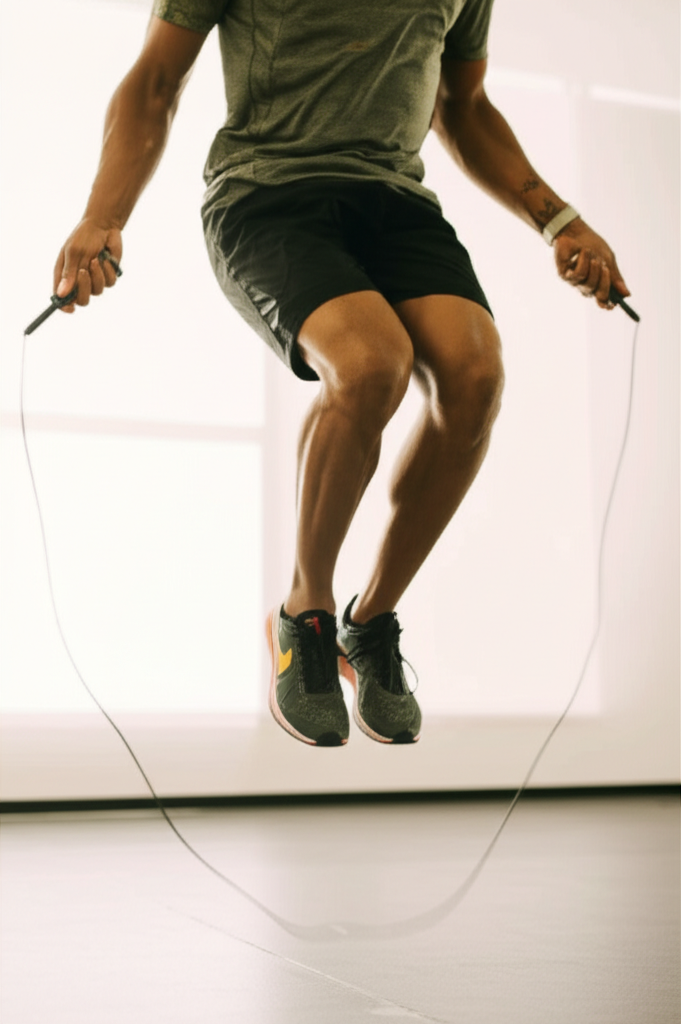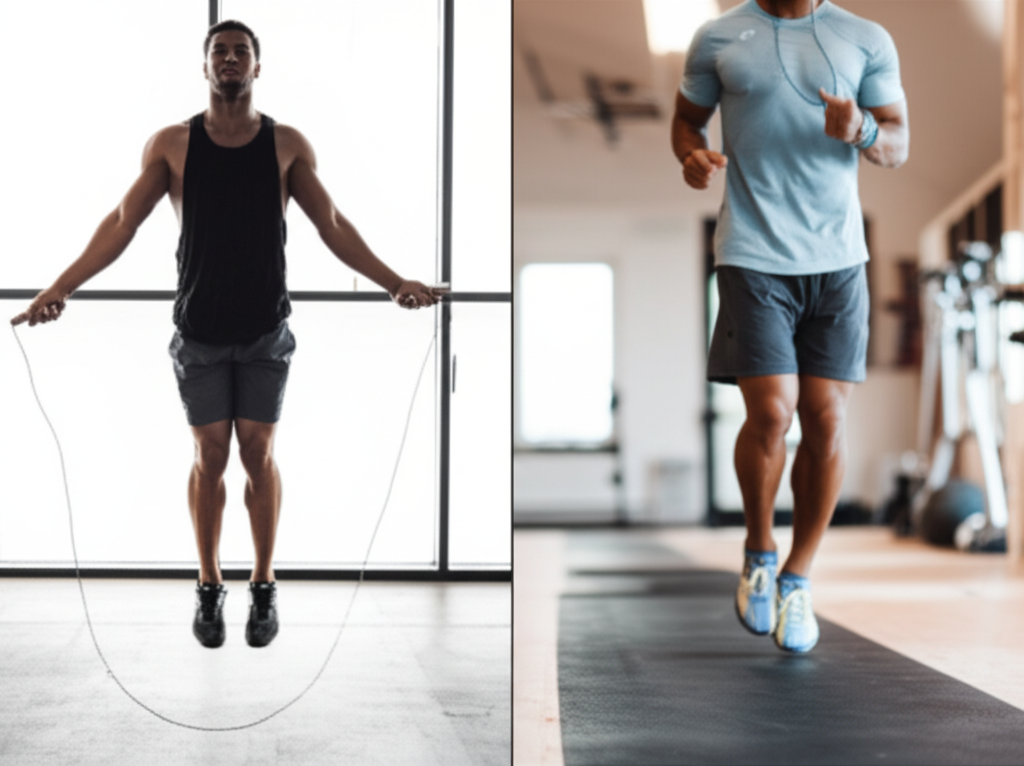In the pursuit of fitness, time is often a critical factor. For those with a packed schedule, a 10-minute workout needs to deliver maximum impact. Two popular and accessible cardiovascular exercises that often come to mind are jumping rope and running. Both offer significant health benefits, but when efficiency for a short, intense session is the goal, which one truly stands out? Let’s delve into a comprehensive comparison to help you make an informed choice for your quick fitness fix.

The Case for Jumping Rope: A High-Intensity Powerhouse
Jumping rope, often underestimated as a childhood pastime, is a formidable full-body workout that can be incredibly efficient for short durations.
Superior Calorie Burn in Less Time
When it comes to calorie expenditure, jumping rope frequently takes the lead, especially at higher intensities. Research suggests that jumping rope can burn a significant number of calories in a short period. For instance, a person weighing 125 pounds could burn around 100 calories in just 10 minutes of jumping rope at an average pace. Increasing the intensity with faster skips or double-unders can elevate this even further, potentially burning up to 10-16 calories per minute. This is often cited as being comparable to, or even exceeding, the calorie burn of running for a longer duration, with some studies indicating 10 minutes of jumping rope can be as efficient as 30 minutes of jogging for cardiovascular benefits.
Comprehensive Muscle Engagement
Unlike running, which primarily targets the lower body, jumping rope offers a more holistic muscle engagement. The rhythmic act of jumping activates major muscle groups throughout the body, including calves, quads, hamstrings, and glutes for propulsion, while the core muscles work constantly for trunk stabilization. Moreover, the continuous rotation of the rope engages the shoulders, biceps, triceps, chest, and back muscles, making it a true full-body workout. This broader muscle activation contributes to a higher energy expenditure in a shorter timeframe.
Enhanced Cardiovascular Benefits
Both jumping rope and running are excellent for cardiovascular health, improving endurance and strengthening the heart. However, jumping rope can elevate your heart rate two to three times faster than most forms of exercise, leading to a highly effective workout in less time. A seminal study by John A. Baker at Arizona State University found that 10 minutes of daily jump rope yielded similar cardiovascular efficiency improvements as 30 minutes of daily jogging over six weeks. This makes it particularly beneficial if you are “pressed for time”. It’s an excellent way to boost cardiovascular fitness and can even improve sprint performance.
Lower Impact on Joints (When Done Correctly)
While both are high-impact activities, jumping rope, when performed with proper technique, can be surprisingly gentle on the joints compared to running. Landing softly on the balls of your feet with slightly bent knees allows your ankles and knees to act as shock absorbers, distributing impact forces evenly. Many runners even incorporate jumping rope on off-days to build ankle stability and prevent shin splints.

The Strengths of Running: Accessibility and Endurance Building
Running remains a cornerstone of cardiovascular fitness for many, offering its own set of distinct advantages.
Accessibility and Simplicity
One of running’s greatest strengths is its sheer accessibility. It requires minimal equipment—primarily a good pair of shoes—and can be done almost anywhere, whether outdoors or on a treadmill. This makes it a convenient option for most individuals without needing specific coordination skills initially.
Endurance and Stamina Development
Running is particularly effective for building endurance and improving lung capacity over longer durations. While a 10-minute run might not build the same endurance as a 30-minute one, consistent short bursts of running, particularly interval running, can still yield significant cardiovascular benefits, improve metabolism, and aid fat loss. These high-intensity bursts can increase endurance and strength by pushing heart, lung, and muscle capabilities.
Mood Boost and Mental Well-being
Many runners report significant mental health benefits, including stress reduction and mood enhancement. The rhythmic nature and opportunity for a change of scenery can contribute positively to mental well-being, which is an important aspect of a sustainable fitness routine.

Direct Comparison for a 10-Minute Routine
| Feature | Jumping Rope | Running |
| :—————— | :—————————————————————————————————————————————————————————————————————————————————————————————————————————————————————————————————————————————————————————————————————————————————————————————————————————————————————————————- | :—————————————————————————————————————————————————————————————————————————————————————————————————————————————————————————————————————————————————————- |
| Calorie Burn | Generally burns more calories per minute, especially at moderate to high intensity. A 10-minute session can burn 100-150 calories or more, depending on intensity. | Calorie burn is similar but may be slightly less per minute at a moderate pace compared to high-intensity jumping rope. A 10-minute run at 6 mph (a 10-minute mile) might burn around 100-120 calories for a 155-pound person. |
| Cardiovascular | Elevates heart rate quickly, making it highly efficient for cardiovascular conditioning in short bursts. Studies suggest 10 minutes can be as effective as 30 minutes of jogging for heart health. | Excellent for building sustained cardiovascular endurance and lung capacity over time. Short, high-intensity intervals in running (sprinting) can also significantly improve heart health and fat loss in minimal time. |
| Muscle Engagement | Full-body workout, engaging calves, quads, hamstrings, glutes, core, shoulders, biceps, and triceps. Improves coordination, agility, and explosive power. | Primarily targets lower body muscles: quads, hamstrings, glutes, and calves. Core muscles provide stabilization. Upper body involvement is minimal unless arm pumping is emphasized. |
| Joint Impact | Can be lower impact than running if proper form is used (landing softly on the balls of the feet with bent knees). Good for building ankle stability and can be an alternative for those with joint concerns. | Generally considered high-impact, especially on hard surfaces. Can put stress on knees and joints over time, though proper form and footwear can mitigate this. |
| Convenience | Requires minimal space and a jump rope. Can be done indoors or outdoors, making it highly versatile and less dependent on weather. | Requires more space (road, track, treadmill). Can be affected by weather conditions. While accessible, a treadmill may compromise affordability for at-home use. |
| Skill Level | Requires some coordination and practice to master different techniques, though basic jumping is accessible. | Generally easier to start for beginners, requiring less specific coordination than intricate jump rope routines. |

The Verdict: Which is More Efficient?
For a 10-minute workout routine focused on maximum efficiency, jumping rope often has a slight edge. It generally burns more calories per minute, provides a more comprehensive full-body workout, and can deliver significant cardiovascular benefits in a shorter timeframe compared to moderate running. The ability to quickly elevate the heart rate and engage multiple muscle groups makes it an excellent choice for a powerful, condensed session.
However, the “better” choice ultimately hinges on individual fitness goals, preferences, and physical condition.
- Choose Jumping Rope if: Your priority is a quick, high-intensity, full-body workout that burns a lot of calories in minimal time, improves coordination, agility, and explosive power, and you need an exercise that can be done in a small space.
- Choose Running if: You prioritize building sustained endurance, enjoy the mental benefits of being outdoors, or are training for distance-based events. If you prefer a lower-skill, more accessible option for consistent long-term cardio, running might be more suitable. Even short bursts of running (sprinting) can offer significant health benefits.

Integrating Both for Optimal Results
Instead of choosing one over the other, incorporating both jumping rope and running into your fitness regimen can provide a well-rounded and highly effective workout plan.
- Use jumping rope for quick, intense cardio bursts and to enhance agility and coordination.
- Utilize running for longer endurance sessions or interval training to build stamina and enjoy outdoor activity.
Both exercises are economical, efficient ways to boost your fitness, burn calories, improve cardiovascular health, and contribute to overall well-being. The key is to find what you enjoy and can stick with consistently.






